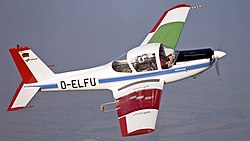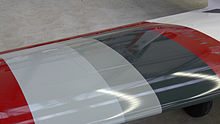LFU 205
| LFU 205 | |
|---|---|

|
|
| Type: | Experimental airplane |
| Design country: | |
| Manufacturer: |
LFU |
| First flight: |
3rd April 1968 |
| Number of pieces: |
1 |
The LFU 205 is an experimental aircraft from the German manufacturer Leichtflugtechnik Union GmbH (LFU).
history
The LFU 205 (initially as Bo 205 designates) was in the 1960s as a technology platform for the plastic construction of the light aviation technology-Union (LFU), a consortium of companies Bölkow , Rhein-aircraft and Pützer Plastics Technology , in cooperation with the DLR developed . For this purpose, the development and construction was funded by various ministries from 1963 onwards with research funds. The preliminary draft came from Hermann Mylius and was modified by Erich Ufer to LFU 205. The first flight took place on April 3, 1968 with Herbert Plasa at the wheel in Laupheim . In 1968 in Hanover, the LFU 205 was described as the most interesting light aircraft at the air show.
The LFU 205 is one of the first powered aircraft in which load-bearing components were also manufactured using fiber composite construction. The hose construction used here was a further development of the so-called open corrugated construction, in which an outer smooth skin is glued to an inner corrugated skin. The shell construction, on the other hand, is a wet-on-wet process for manufacturing sandwich shells. Starting from a glass fabric hose with a woven-in plastic hose, a cover skin made of glass fiber fabric is first laminated onto this winding core. This core is placed in the outer negative mold into which the outer cover layer was previously laminated. After closing the outer two-part mold, the plastic tubes are inflated and the fabric tubes are pressed firmly against the cover layers. Even after hardening, the very thin plastic tubes remain in the sandwich.
The process was then also used in the manufacture of a C-160 transall elevator. The machine received its type approval as a single piece on March 16, 1977. Series production was not initiated for cost reasons and other orders. From 1984 it was used as a development vehicle for laminar airfoils at the DLR in Braunschweig . In 2017 the LFU 205 was decommissioned. The last flight led to Schleissheim Airfield on June 22, 2017. There it will now be exhibited in the Schleissheim aircraft yard .
construction
The LFU 205 is a low- wing aircraft made of GRP and is driven by a Lycoming I0-360 engine with 147 kW and a variable-pitch propeller Hartzell HC-C2YK-1 B. The two tanks each have a capacity of 96 l, which means that a maximum flight time of 3.5 hours is possible.
Technical specifications
| Parameter | Data |
|---|---|
| crew | 2 |
| Passengers | 2 |
| length | 7.44 m |
| span | 10.50 m |
| height | 2.30 m |
| Wing area | 16.35 m² |
| payload | ? kg |
| Empty mass | 947 kg |
| Max. Takeoff mass | 1280 kg |
| Cruising speed | 140 kts |
| Top speed | 325 km / h |
| Service ceiling | 3600 m (12,000 ft) |
| Range | 550 NM |
| Engines | a Lycoming IO-360 A1C with 200 PS (147 kW) |
See also
Individual evidence
- ↑ 7th German Air Show, Aircraft of General Aviation, FlugRevue July 1968, p. 23
- ↑ G. Niederstadt: Development of a light touring aircraft made of glass fiber plastic , on kunststoffe.de ( Memento from March 17, 2007 in the Internet Archive ) (PDF file; 1.1 MB; accessed on July 29, 2018)
- ↑ FliegerRevue December 2010, pp. 56–59, plastics on the advance
- ↑ Blog of the Deutsches Museum
- ↑ LFU 205 (DLR)
